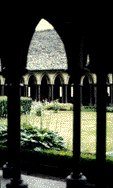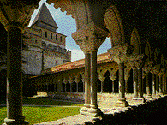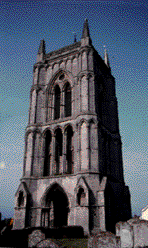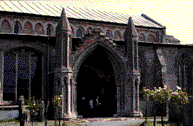


oon after, I started studying medieval architecture in earnest.
If I hadn't been snagged by literature first, I might well have become an
art historian. Why? Because the cathedrals and churches

were deeply impressive
in a variety of ways. A monastery like Mont St. Michel, built on an island
in the English Channel, needs no justification from me. It is profoundly
beautiful. Within the walls, it has a cloister (as all monasteries do), a
covered walk where the monks could walk for exercise or meditation, could
wash, could copy manuscripts in good light without being subject to the
weather directly. Every cloister is different in its details and its
proportions, and--to my mind--every one is beautiful, with its changing
light and its garden or cloister "garth."



 athedrals also have towers of myriad kinds and sizes and
styles, depending on the region and the period. West Walton, in Norfolk
(in the east of England), has a beautiful late medieval parish church with
a stepped tower that seems more magnificent than a church its size would
warrant, but then we all know about people who show off when they build.
Just look at the Empire State Building--or the big houses in the historic
district of any American town old enough to have one.
athedrals also have towers of myriad kinds and sizes and
styles, depending on the region and the period. West Walton, in Norfolk
(in the east of England), has a beautiful late medieval parish church with
a stepped tower that seems more magnificent than a church its size would
warrant, but then we all know about people who show off when they build.
Just look at the Empire State Building--or the big houses in the historic
district of any American town old enough to have one.
 At the other
end of the spectrum, Exeter Cathedral has monumental towers from the
Norman period, some two hundred years earlier. Not only are they
beautifully designed, but they have elaborate surface decoration, a
different pattern to each level of the tower, that makes them more than
just "a pile of old stones," as a friend once off-handedly
described (all) cathedrals to me. Other cathedrals are like "cities
of towers"; the effect
At the other
end of the spectrum, Exeter Cathedral has monumental towers from the
Norman period, some two hundred years earlier. Not only are they
beautifully designed, but they have elaborate surface decoration, a
different pattern to each level of the tower, that makes them more than
just "a pile of old stones," as a friend once off-handedly
described (all) cathedrals to me. Other cathedrals are like "cities
of towers"; the effect  inspires not admiration for a single piece of work, but
dazzlement at so much in one place.
inspires not admiration for a single piece of work, but
dazzlement at so much in one place.
Walk around any cathedral and
try to imagine how men built them without modern technology. Below
are the facades (fronts) of Exeter Cathedral, in the south-west of
England and St. Albans, just north of London. Think of building them
without the engineering expertise and equipment available to us. On
the other hand, don't imagine medieval builders as primitive. These
buildings are not like the pyramids, built with slave labor. These
builders had machines of many kinds (winches, cranes, and such, though
not of course built of steel like ours) and a deep understanding of
geometry. "Primitives" do not build flying buttresses, like the ones
you see in the third picture of the east end of Bourges Cathedral
in France. Those buttresses allow such huge structures to contain
very large windows while still supporting the walls. Not bad for the
fourteenth century!